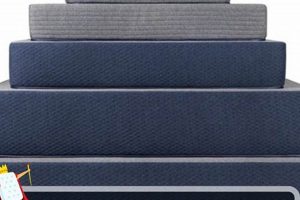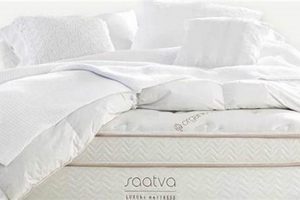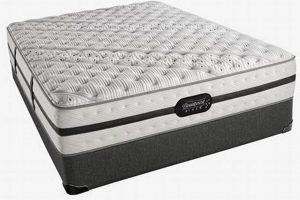The selection of an appropriate sleep surface is a critical consideration for individuals diagnosed with scoliosis. This condition, characterized by an abnormal curvature of the spine, can lead to discomfort and pain, particularly during periods of rest. A sleep surface that provides adequate support and pressure relief is therefore essential for promoting spinal alignment and minimizing pain. For example, a mattress that conforms to the body’s contours can help distribute weight evenly, reducing stress on specific pressure points along the spine.
Prioritizing a suitable sleep surface contributes significantly to managing scoliosis-related discomfort. A well-chosen mattress can improve sleep quality, reduce pain, and promote better spinal alignment. Historically, individuals with scoliosis were often limited to very firm mattresses, based on the belief that they offered superior support. However, contemporary understanding emphasizes the need for a balance between support and pressure relief. The right surface facilitates a more comfortable and restorative sleep experience, which can positively impact overall well-being.
Further discussion will explore specific mattress types known for their potential benefits in alleviating scoliosis-related symptoms, including memory foam, latex, and hybrid models. Characteristics such as firmness levels, zoning, and material composition will be examined to provide a comprehensive understanding of how these factors contribute to optimal spinal support and comfort.
Guidance on Mattress Selection for Scoliosis
Selecting an appropriate mattress is vital for individuals with scoliosis seeking to minimize discomfort and promote spinal alignment during sleep. The following points offer guidance on key considerations in the mattress selection process.
Tip 1: Prioritize Spinal Support: A mattress should provide sufficient support to maintain the natural curvature of the spine. Lack of support can exacerbate scoliosis-related pain and discomfort.
Tip 2: Consider Pressure Relief: The sleep surface should effectively distribute body weight to minimize pressure on sensitive areas, such as the shoulders and hips. Materials like memory foam or latex often excel in pressure relief.
Tip 3: Evaluate Firmness Level: The optimal firmness level is subjective and depends on individual preferences and body type. Generally, a medium-firm mattress is recommended to provide a balance of support and comfort for those with scoliosis.
Tip 4: Research Mattress Materials: Memory foam, latex, and innerspring mattresses offer different levels of support, pressure relief, and temperature regulation. Researching the properties of each material is essential for informed decision-making.
Tip 5: Assess Zoning Features: Mattresses with zoned support provide varying levels of firmness to different areas of the body. This can be beneficial for individuals with scoliosis, as it offers targeted support to the spine.
Tip 6: Read Reviews and Testimonials: Consult reviews and testimonials from other individuals with scoliosis to gain insights into the performance of different mattress models. However, remember that individual experiences may vary.
Tip 7: Trial Period: Consider mattresses with a trial period. This allows for sufficient time to evaluate the mattress’s suitability and ensure it meets the individual’s comfort and support needs.
In summary, the optimal mattress will offer a balance of spinal support, pressure relief, and personalized comfort. Careful consideration of these factors can significantly improve sleep quality and reduce scoliosis-related pain.
The subsequent sections will delve deeper into specific mattress types and their potential advantages for individuals managing scoliosis.
1. Spinal Alignment
Maintaining proper spinal alignment during sleep is paramount for individuals with scoliosis. The chosen mattress plays a crucial role in facilitating this alignment, directly impacting pain levels and overall comfort. A sleep surface that fails to support the natural curvature of the spine can exacerbate existing spinal imbalances, leading to increased discomfort and potential long-term complications.
- Contouring and Support Balance
An effective mattress must strike a balance between contouring to the body’s unique shape and providing adequate support to prevent spinal misalignment. Insufficient support can cause the spine to sag, while excessive firmness can create pressure points. Memory foam and latex materials are often favored due to their ability to conform to the body while maintaining a supportive structure. The specific material composition and construction of the mattress directly influence its capacity to promote proper spinal positioning.
- Pressure Distribution
Uneven pressure distribution can lead to spinal misalignment and localized pain. A mattress that evenly distributes weight across its surface reduces stress on specific areas of the spine, allowing for a more natural and comfortable sleep posture. Zoned support systems, which feature varying levels of firmness in different areas of the mattress, can further enhance pressure distribution and promote optimal spinal alignment. These systems target specific areas, such as the lumbar region, to provide customized support where it is most needed.
- Sleeping Position Considerations
The impact of a mattress on spinal alignment is influenced by an individual’s preferred sleep position. Side sleepers, for example, require a mattress that allows the shoulder and hip to sink in slightly, maintaining spinal alignment. Back sleepers need adequate support in the lumbar region to prevent the spine from arching excessively. Stomach sleeping is generally discouraged for individuals with scoliosis, as it can exacerbate spinal misalignment regardless of the mattress type. The mattress selection process should therefore consider the individual’s dominant sleep position to ensure optimal spinal support.
- Long-Term Spinal Health
Consistent use of an inappropriate mattress can contribute to the progression of scoliosis-related symptoms and potentially lead to chronic pain. Investing in a mattress that promotes proper spinal alignment is a proactive step towards maintaining long-term spinal health. Regular assessment of the mattress’s condition and its continued ability to provide adequate support is essential. Over time, mattresses can lose their supportive properties, necessitating replacement to ensure ongoing spinal alignment and comfort.
The facets above underscore the profound connection between spinal alignment and the selection of an optimal sleep surface. A mattress that effectively addresses contouring, support, pressure distribution, and sleeping position considerations contributes significantly to managing scoliosis-related discomfort and promoting long-term spinal health. The selection process should be guided by a comprehensive understanding of these factors to ens
ure a personalized and effective solution.
2. Pressure Relief
Pressure relief is a crucial component of a mattress deemed suitable for individuals with scoliosis. The abnormal spinal curvature characteristic of scoliosis often results in uneven weight distribution and increased pressure on specific points along the spine, hips, and shoulders. An inadequate sleep surface can exacerbate this pressure, leading to pain, discomfort, and disrupted sleep. Mattresses designed with pressure-relieving materials aim to redistribute body weight, minimizing concentrated stress on these vulnerable areas. For example, memory foam, a viscoelastic material, conforms to the body’s contours, effectively cushioning pressure points and promoting a more even weight distribution. Latex, another pressure-relieving option, offers a responsive and resilient surface that alleviates stress without sacrificing support. The effective mitigation of pressure build-up enables a more comfortable and restorative sleep experience for those with scoliosis.
The practical significance of understanding pressure relief in the context of scoliosis extends to improved pain management and enhanced sleep quality. By reducing pressure on sensitive areas, the individual experiences less discomfort, allowing for a deeper and more restful sleep. Furthermore, consistent pressure relief can help prevent the development of secondary issues, such as muscle spasms and nerve impingement, which can arise from prolonged pressure on compromised areas of the spine. The selection of a mattress with adequate pressure-relieving properties should be guided by individual needs and preferences, considering factors such as body weight, sleeping position, and specific areas of discomfort. Mattress models incorporating zoned support systems, which offer varying levels of firmness across different areas of the mattress, further enhance pressure relief by providing targeted support to specific body regions.
In summary, the relationship between pressure relief and the optimal mattress for scoliosis is undeniable. Adequate pressure relief is essential for minimizing pain, promoting spinal alignment, and improving sleep quality in individuals with this condition. The selection of a mattress with appropriate pressure-relieving properties, often achieved through materials like memory foam or latex, represents a critical step in managing scoliosis-related discomfort. While material composition is paramount, a holistic approach also considers firmness level, zoned support, and individual sleeping preferences to ensure a personalized and effective solution. The challenge lies in finding the ideal balance between support and pressure relief to meet the unique needs of each individual with scoliosis.
3. Firmness Level
Firmness level is a crucial consideration when selecting a sleep surface for individuals with scoliosis. The appropriate firmness directly impacts spinal alignment, pressure distribution, and overall comfort. A mismatch between firmness and individual needs can exacerbate scoliosis-related discomfort and disrupt sleep quality.
- Spinal Support and Curvature
Mattress firmness either supports or undermines the natural curvature of the spine. Individuals with scoliosis require a mattress that prevents excessive spinal rotation or lateral bending during sleep. A mattress that is too soft may allow the spine to sink, while one that is too firm may not conform to the body’s contours. A medium-firm mattress often provides a balance, offering support while allowing for some contouring to alleviate pressure points. For instance, a medium-firm latex mattress can provide the necessary support to maintain spinal alignment without creating undue pressure on the hips and shoulders, a common problem for side sleepers with scoliosis.
- Pressure Distribution
Firmness level directly affects how body weight is distributed across the mattress surface. A mattress that is too firm concentrates pressure on bony prominences, such as the hips and shoulders. Conversely, a mattress that is too soft may not provide adequate support, leading to pressure buildup in the lumbar region. A balanced firmness level, often found in medium-firm mattresses, promotes even weight distribution, reducing stress on specific areas of the body. Hybrid mattresses, which combine innerspring coils with a comfort layer of memory foam or latex, often offer a customizable firmness that addresses both support and pressure relief.
- Sleeping Position
The ideal firmness level varies based on preferred sleeping position. Side sleepers typically benefit from a softer mattress to allow the shoulder and hip to sink in slightly, maintaining spinal alignment. Back sleepers often require a firmer mattress to provide adequate support to the lumbar region. Stomach sleeping is generally discouraged for individuals with scoliosis, as it can exacerbate spinal misalignment regardless of mattress firmness. Understanding one’s dominant sleeping position is essential for selecting a mattress with an appropriate firmness level. Adjustable air mattresses allow users to customize firmness, catering to various sleeping positions and individual support needs.
- Individual Body Weight and Build
Body weight and build influence the perception of mattress firmness. Heavier individuals generally require a firmer mattress to prevent excessive sinking and maintain spinal alignment. Lighter individuals may find a softer mattress more comfortable, as it allows for greater contouring and pressure relief. Considering body weight and build is essential for selecting a mattress with an appropriate firmness level. Mattress manufacturers often provide firmness recommendations based on weight ranges, providing a valuable starting point for the selection process. However, personal preference and individual needs should also be taken into account.
In summary, the selection of a mattress with an appropriate firmness level is crucial for individuals with scoliosis. Factors such as spinal support, pressure distribution, sleeping position, and individual body weight all contribute to determining the ideal firmness. A balanced approach that considers these variables is essential for promoting spinal alignment, minimizing discomfort, and improving overall sleep quality. Ultimately, testing different firmness levels and seeking professional guidance from a sleep specialist can assist in identifying the optimal firmness for individual needs.
4. Material Composition
The material composition of a mattress exerts a significant influence on its suitability for individuals with scoliosis. The properties of the materials used directly affect spinal support, pressure distribution, temperature regulation, and overall durability. Understanding the characteristics of different mattress materials is crucial for making an informed decision that aligns with specific comfort and support needs.
- Memory Foam and Spinal Alignment
Memory foam, a viscoelastic material, is renowned for its ability to conform closely to the body’s contours. This characteristic can be advantageous for individuals with scoliosis, as it promotes even
weight distribution and reduces pressure points. However, the density and firmness of memory foam vary significantly. High-density memory foam provides greater support and durability, while lower-density foam offers enhanced pressure relief. In the context of scoliosis, a balance between support and pressure relief is essential. For example, a memory foam mattress with zoned support, featuring varying densities in different areas, can provide targeted support to the lumbar region while cushioning the shoulders and hips. The material’s heat retention properties are a potential drawback, often addressed through the incorporation of cooling technologies, such as gel infusions or open-cell structures. - Latex and Responsiveness
Latex, derived from either natural rubber or synthetic materials, offers a responsive and resilient sleep surface. Natural latex, in particular, is prized for its durability, breathability, and hypoallergenic properties. Latex mattresses provide a supportive feel without the excessive sinking associated with some memory foam models. This responsiveness can facilitate easier movement during sleep, which may be beneficial for individuals with scoliosis who experience discomfort when remaining in one position for extended periods. For instance, a Dunlop latex mattress, known for its density and firmness, can provide excellent spinal support for back sleepers with scoliosis. Conversely, a Talalay latex mattress, which is softer and more breathable, may be preferable for side sleepers seeking pressure relief.
- Innerspring Systems and Support
Innerspring mattresses, characterized by a network of interconnected or individually wrapped coils, offer a traditional approach to sleep surface support. The gauge and configuration of the coils significantly impact the mattress’s firmness and support level. While innerspring mattresses can provide adequate support for some individuals with scoliosis, they often lack the contouring and pressure relief capabilities of memory foam or latex models. Hybrid mattresses, which combine an innerspring core with a comfort layer of memory foam or latex, attempt to bridge this gap. These hybrid models aim to provide the support of an innerspring system with the pressure-relieving benefits of other materials. For example, a hybrid mattress with a pocketed coil system and a memory foam comfort layer can offer targeted support and contouring, potentially mitigating scoliosis-related discomfort.
- Hybrid Constructions and Comprehensive Benefits
Hybrid mattresses strategically combine different materials, aiming to leverage the strengths of each. A common example involves pairing an innerspring core with a top layer of memory foam or latex. This construction seeks to provide both robust support and conforming pressure relief. The effectiveness of a hybrid design depends heavily on the quality and arrangement of its constituent materials. For instance, a hybrid mattress with a high-gauge pocketed coil system topped with a thick layer of high-density memory foam can offer excellent spinal support and pressure relief. The arrangement of these layers, along with any zoning considerations, determines the overall feel and suitability for individuals with scoliosis. Careful consideration of the materials used and their configuration is essential for maximizing the potential benefits of a hybrid mattress.
Ultimately, the selection of mattress materials for individuals with scoliosis necessitates a careful evaluation of individual needs and preferences. Factors such as spinal alignment requirements, pressure relief needs, preferred sleeping position, and body weight all contribute to determining the optimal material composition. Hybrid mattresses often present a versatile option, allowing for a tailored combination of support and comfort. While material properties are crucial, the overall construction, firmness level, and zoning features of the mattress also play a significant role in its suitability. Consulting with a healthcare professional or sleep specialist can provide personalized guidance and facilitate an informed decision.
5. Zoned Support
Zoned support, a feature incorporated into many contemporary mattresses, is of notable relevance when considering optimal sleep surfaces for individuals with scoliosis. This design element involves varying the firmness or support levels across different sections of the mattress, with the intention of providing targeted support to specific areas of the body. Its application in the context of scoliosis aims to address the unique spinal alignment and pressure distribution challenges associated with the condition.
- Lumbar Support Enhancement
The lumbar region of the spine often requires enhanced support in individuals with scoliosis to prevent excessive sinking and maintain proper alignment. Zoned support systems can incorporate firmer materials or coil configurations in the lumbar area to provide this targeted support. For example, a mattress might feature a central zone with higher-gauge coils or denser foam to prevent the midsection from sagging during sleep. This targeted support aims to reduce strain on the spinal muscles and ligaments, mitigating discomfort and promoting a more neutral spinal posture. The long-term implications include potentially reduced pain and improved sleep quality.
- Shoulder and Hip Pressure Relief
Side sleeping, a common position, can place significant pressure on the shoulders and hips. Zoned support systems can incorporate softer materials or modified coil arrangements in these areas to alleviate pressure points. A mattress designed with softer zones around the shoulders and hips allows these areas to sink slightly, maintaining spinal alignment and reducing discomfort. For example, a mattress might use a softer memory foam in the shoulder zone to cushion the joint and prevent pressure buildup. This feature is particularly relevant for individuals with scoliosis, as the condition can exacerbate pressure-related pain.
- Spinal Alignment Maintenance
The overarching goal of zoned support is to promote and maintain proper spinal alignment throughout the night. By providing targeted support and pressure relief, these systems aim to minimize spinal rotation and lateral bending. The specific configuration of the zoned support system should ideally align with the individual’s body shape and sleeping position. For instance, a mattress designed for a back sleeper might feature a firmer lumbar zone and a softer shoulder zone to accommodate the natural curvature of the spine. The success of a zoned support system hinges on its ability to adapt to the individual’s unique needs and provide consistent support across different areas of the body.
- Customization and Adaptability
The effectiveness of zoned support is heightened when customization options are available. Some mattresses offer adjustable zoning, allowing users to fine-tune the firmness and support levels in different areas. This adaptability is particularly beneficial for individuals with scoliosis, as the condition’s severity and specific symptoms can vary widely. A mattress with adjustable zoning can be customized to address individual pain points and alignment issues. For example, an individual with a pronounced curvature in the thoracic spine might benefit from enhanced support in that area, which can be achieved through adjustable zoning features. Ultimately, the ability to personalize the support level is crucial for optimizing comfort and promoting long-term spinal health.
In conclusion, the incorporation of zoned support into
a mattress represents a strategic approach to addressing the specific needs of individuals with scoliosis. By providing targeted support and pressure relief, zoned support systems aim to promote spinal alignment, minimize discomfort, and improve sleep quality. While the specific configuration of the zoned support system should be tailored to the individual’s body shape and sleeping position, the underlying principle remains consistent: to provide customized support where it is most needed, contributing to the selection of an optimal sleep surface for managing scoliosis-related symptoms.
6. Trial Period
The trial period associated with mattress purchases assumes paramount importance when individuals are seeking the most suitable sleep surface for managing scoliosis. Given the subjective nature of comfort and the nuanced support requirements dictated by spinal curvature, a trial period facilitates informed decision-making beyond the limitations of in-store testing.
- Extended Assessment of Spinal Alignment
A trial period permits extended evaluation of spinal alignment in one’s typical sleep environment. The brief interaction with a mattress in a retail setting offers limited insight into how the surface will perform over consecutive nights. Individuals with scoliosis require the opportunity to assess whether a mattress consistently maintains proper spinal alignment throughout the night, mitigating pain and discomfort. A home trial provides the necessary time to observe the long-term impact on spinal posture and overall well-being. For example, an individual may initially perceive a mattress as comfortable in-store, only to discover that it exacerbates lumbar pain after a week of use. The trial period enables the discernment of subtle yet critical differences in spinal support that are not readily apparent during a short assessment.
- Adaptation and Accommodation
The human body requires a period of adaptation to a new sleep surface. Muscles and ligaments may initially experience tension or soreness as they adjust to the mattress’s support characteristics. A trial period allows for this adaptation process to occur, preventing premature judgments about the mattress’s suitability. Individuals with scoliosis, who may have pre-existing muscle imbalances or sensitivities, particularly benefit from this extended adjustment period. For instance, a mattress that initially feels too firm may become more comfortable as the body acclimates to its support. Conversely, a mattress that initially feels ideal may prove inadequate over time as the body’s adaptation reveals shortcomings in spinal support. The trial period serves as a valuable buffer, allowing for a comprehensive understanding of the mattress’s long-term comfort and support characteristics.
- Consideration of Variable Sleep Conditions
Sleep quality can be influenced by various factors, including stress levels, physical activity, and environmental conditions. A trial period enables the assessment of the mattress’s performance under diverse sleep conditions. Individuals with scoliosis may experience fluctuations in pain levels and discomfort depending on these external factors. A mattress that provides adequate support during periods of low stress may prove insufficient during times of heightened physical exertion or emotional tension. The trial period allows for the observation of the mattress’s consistency and adaptability under a range of circumstances. This comprehensive evaluation provides a more realistic assessment of its long-term suitability for managing scoliosis-related symptoms.
- Mitigation of Risk and Financial Security
The purchase of a mattress represents a significant financial investment. The inclusion of a trial period mitigates the financial risk associated with selecting an unsuitable sleep surface. Individuals with scoliosis may need to experiment with different mattress types and firmness levels before finding the optimal solution. Without a trial period, the financial burden of purchasing multiple mattresses can be substantial. A trial period provides a safety net, allowing for the return of the mattress if it fails to meet expectations, preventing unnecessary financial losses. This security empowers individuals to make more confident and informed decisions about their mattress selection, knowing that they have the option to return the product if it does not adequately address their specific needs.
In essence, the trial period is an indispensable component in the pursuit of a mattress that effectively addresses the unique needs of individuals with scoliosis. It transcends the limitations of brief in-store assessments, providing the necessary time and context to evaluate spinal alignment, adapt to the sleep surface, consider variable sleep conditions, and mitigate financial risk. The trial period ultimately empowers informed decision-making, increasing the likelihood of selecting a mattress that promotes long-term comfort, spinal health, and improved sleep quality.
Frequently Asked Questions
This section addresses common inquiries regarding the selection of a mattress suitable for individuals with scoliosis, providing evidence-based information to facilitate informed decision-making.
Question 1: Does mattress firmness directly correlate with spinal support for scoliosis?
While firmness contributes to spinal support, it is not the sole determinant. A balance between firmness and contouring is essential. A mattress should prevent excessive sinking while conforming to the body’s natural curves to distribute pressure evenly. An excessively firm mattress can create pressure points, while one that is too soft may lack adequate support.
Question 2: Are memory foam mattresses universally recommended for individuals with scoliosis?
Memory foam mattresses offer pressure relief and contouring benefits that can be advantageous for individuals with scoliosis. However, not all memory foam mattresses are created equal. High-density memory foam provides greater support, while lower-density foam offers enhanced pressure relief. Individual preferences and specific needs should guide the selection.
Question 3: What role does sleeping position play in choosing a mattress for scoliosis?
Sleeping position significantly impacts the type of mattress that is most suitable. Side sleepers typically require a softer mattress to allow the shoulder and hip to sink in slightly, maintaining spinal alignment. Back sleepers often benefit from a firmer mattress to provide adequate lumbar support. Stomach sleeping is generally discouraged.
Question 4: Is zoned support a necessary feature in a mattress for scoliosis?
Zoned support can be beneficial, as it provides targeted support and pressure relief to different areas of the body. However, its necessity depends on individual needs and preferences. Individuals with specific pain points or alignment issues may find zoned support particularly helpful. Mattresses without zoned support can still provide adequate comfort and support if they offer a balanced combination of firmness, contouring, and pressure relief.
Question 5: How important is it to consider the trial period offered by mattress retailers?
The trial period is a crucial aspect of the mattress selection process. It allows individuals to assess the mattress’s suitability in their own sleep environment over an extended period. This is particularly important for individuals with scoliosis, as it provides the opportunity to evalu
ate spinal alignment, comfort, and pressure relief over time.
Question 6: Can a mattress alone resolve scoliosis-related discomfort?
A mattress can significantly improve comfort and support for individuals with scoliosis, but it is not a substitute for medical treatment. A comprehensive approach to managing scoliosis-related discomfort often involves a combination of physical therapy, exercise, and appropriate sleep support. Consulting with a healthcare professional is essential for developing a personalized treatment plan.
In summary, selecting an appropriate mattress is a critical component of managing scoliosis-related discomfort. Factors such as firmness, material composition, sleeping position, and the availability of a trial period should all be carefully considered.
The subsequent section will offer guidance on integrating mattress selection with other strategies for managing scoliosis.
Conclusion
The preceding exploration has illuminated the multifarious factors influencing the selection of the best type of mattress for scoliosis. These encompass the critical elements of spinal alignment, pressure relief, firmness level, material composition, zoned support, and the invaluable benefit of a trial period. A comprehensive understanding of these aspects is essential for individuals seeking to mitigate scoliosis-related discomfort and optimize sleep quality.
Selecting the most appropriate sleep surface represents a significant step towards improved comfort and spinal health for those affected by scoliosis. Although a mattress alone cannot serve as a definitive treatment for scoliosis, its role in managing associated symptoms is undeniable. Continued research and advancements in mattress technology hold the potential to further enhance the comfort and well-being of individuals navigating this condition, underscoring the importance of informed decision-making in this domain.


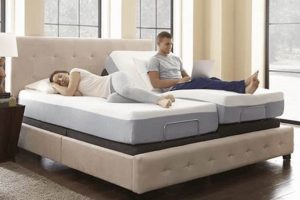
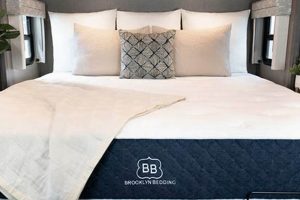
![Top Rated Best Wyoming King Mattress [Review] Organic & Natural Mattress Buyer’s Guide: Non-Toxic Sleep Solutions Top Rated Best Wyoming King Mattress [Review] | Organic & Natural Mattress Buyer’s Guide: Non-Toxic Sleep Solutions](https://mattressworldpa.com/wp-content/uploads/2025/07/th-7657-300x200.jpg)
